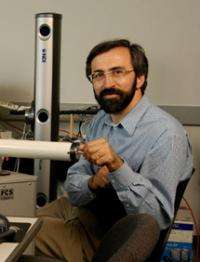Engineer helps stroke patients regain motor functions in hands, arms

Helping stroke patients regain use of their hands and arms through innovative robotic and virtual reality-based video game therapies is the focal point of NJIT Associate Professor Sergei Adamovich, a biomedical engineer. Thanks to a $1.3 million grant from the National Institutes of Health (NIH), Adamovich is developing better ways to rehabilitate people who have lost control of their hands, fingers, shoulders and elbows.
Preliminary laboratory results appear promising: A group of 20 recent subjects has shown 20 to 28 percent positive changes in motor function following participation.
"Strokes are the largest cause of disability in adults in the U.S.," Adamovich said. That's why we feel our research is important. More people than ever survive strokes and live longer lives, but they are hobbled by major disabilities. We would like to see that change and give stroke patients the opportunity to live better lives."
While other researchers around the nation have pursued similar therapies, only a few currently focus on hand functions. Adamovich's team is trying to determine whether it is better to train the hand and arm separately or together. Physical therapists collaborating with him assist in the design of therapeutic interventions for the technology.
Two at a time, subjects come to Adamovich's sixth floor laboratory in Fenster Hall on the NJIT campus. Once there, they spend up to three hours a day, five days a week, for two weeks to play video games. In one game, their arms are attached to a robot called the Haptic Master. The robot, supporting their weakened arms, enables them to touch virtual spheres, which if done correctly will explode with a satisfying boom. At first glance, the uninitiated might imagine he has stepped into a video arcade. For finger strengthening exercises, subjects in another room play a simulated piano keyboard on a wall-hung computer screen.
Interestingly, the researchers want subjects as young as 25 and as old as 80. "Age makes no difference when it comes to making improvements," Adamovich adds. Even more surprising, they've had people come to them as many as 15 years past their strokes and make even better progress than individuals six months after the event.
Today's work is based upon a research paper by Adamovich that appeared in 2006: "Sensorimotor training in a virtual reality environment: Does it improve functional recovery post-stroke?"(Neurorehabilitation and Neural Repair). The paper detailed an earlier version of what's in his lab today. "We weren't using the kinds of robotic arms that we have now," said Adamovich. "Subjects played computer games using hand/finger motions in a special glove capable of measuring their finger movements." Additionally, the training used only hands, unlike now, in which the technology has enabled hand-training to be combined with robot-assisted elbow and shoulder-training.
Adamovich, a physicist by education, began studying how the brain controls hand and arm function because of an underlying interest in the basic research principles of brain and body movement, planning and execution. Several years ago, he moved into applied research. "We believe that motor control and learning are important when trying to understand rehabilitation," he said. "Neuroscience has demonstrated through animal studies that you can induce changes in adult brain networks through intensive stimulation and sensory motor training. And, thanks to the recent changes in technology—especially the availability of robots—this whole area of neuro-rehabilitation has taken off."














